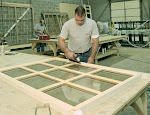When you work on the preservation of historic properties, it
is always exciting to discover some hidden artifact preserved for decades.
Recently while I was removing wallpaper from a wall in the hallway of my home,
I discovered a hidden signature on the plaster that said, “This wall finished
papering by WM Pelletier, July 21st, 1910”. William Pelletier was so
proud of his work back in 1910 he was compelled to sign his name. As I
reflected upon this discovery, I realized that it captures a major shift in
people’s attitudes from then to now. The era of taking pride in a job well done
is being threatened.
Thirty-plus years ago, the net worth of an individual was
measured by the competence of his/her work. No matter what vocation you were in,
whether it be doctor, politician, professional athlete, or tradesman, the
skills deployed in your work were a direct reflection of who you were. In the
construction trades, this meant you attended to the details of your job even
when nobody noticed. It meant you went the extra mile because you saw your work
as being a reflection of your values. You put your best effort into everything
you did, not because someone was watching, but because that is who you were.
Over the past fifteen years, there has been a shift in this
ethos. Work no longer defines our character. Our vocation has morphed into a
means to support the activities we truly enjoy. Work is work, not an activity
that fulfills our purpose. This attitude fuels a work ethic based upon doing
the bare minimum to just get the job done. The goal of work is now to make as
much money as you can rather than do the best job possible. You see this
behavior in retail workers, flight attendants, and the health industry. It has
become so pervasive that it can be rare to find someone who truly enjoys their work.
In the construction industry, the minimalist state of mind
has produced an industry of checks and balances put into place to assure that work
is done to satisfactory levels. Instead of relying on the pride of the workforce,
we depend upon detailed specifications defining all work processes. Excellence
is achieved by a system of quality control measures where workers are monitored
by management, video surveillance, and QC checks. Re-View, for example, uses a
litany of tests to assure quality control on all of our work. The days are gone
where all you had to do is tell someone how to perform a task. Now you have to
check their work to ensure all of the details are satisfied.
I don’t know how we got here. Maybe it is a result of us
Baby Boomers spoiling our kids and burning ourselves out in the pursuit of a desired
status of living. Maybe it is an outgrowth of the Great Recession where careers
were displaced and employers began to treat the staff like disposable assets. It
could be a product of social media, where people are more concerned with how
they are perceived in a virtual reality rather than in the real world. It could
also be a result of the pursuit of the almighty buck at the expense of
everything else. Or perhaps it is some combination of these and other factors
that have shifted our perspective.
The construction industry is at a turning point. A
generation of people dedicated to their trade is about to retire, and there are
too few self-motivated people in the system ready to take the lead. If the next
generation of leaders is more interested in making it to Friday than making a
difference, we are all in trouble.






